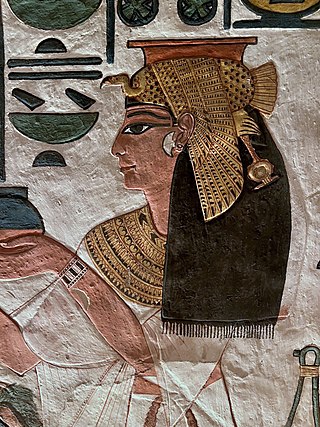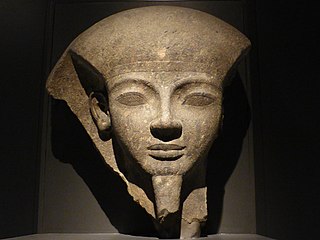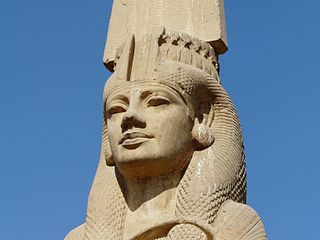
Nefertari, also known as Nefertari Meritmut, was an Egyptian queen and the first of the Great Royal Wives of Ramesses the Great. She is one of the best known Egyptian queens, among such women as Cleopatra, Nefertiti, and Hatshepsut, and one of the most prominent not known or thought to have reigned in her own right. She was highly educated and able to both read and write hieroglyphs, a very rare skill at the time. She used these skills in her diplomatic work, corresponding with other prominent royals of the time. Her lavishly decorated tomb, QV66, is one of the largest and most spectacular in the Valley of the Queens. Ramesses also constructed a temple for her at Abu Simbel next to his colossal monument there.

Menmaatre Seti I was the second pharaoh of the Nineteenth Dynasty of Egypt during the New Kingdom period, ruling c. 1294 or 1290 BC to 1279 BC. He was the son of Ramesses I and Sitre, and the father of Ramesses II.

Abu Simbel is a historic site comprising two massive rock-cut temples in the village of Abu Simbel, Aswan Governorate, Upper Egypt, near the border with Sudan. It is located on the western bank of Lake Nasser, about 230 km (140 mi) southwest of Aswan. The twin temples were originally carved out of the mountainside in the 13th century BC, during the 19th Dynasty reign of the Pharaoh Ramesses II. Their huge external rock relief figures of Ramesses II have become iconic. His wife, Nefertari, and children can be seen in smaller figures by his feet. Sculptures inside the Great Temple commemorate Ramesses II's heroic leadership at the Battle of Kadesh.

Ramesses VI Nebmaatre-Meryamun was the fifth ruler of the Twentieth Dynasty of Egypt. He reigned for about eight years in the mid-to-late 12th century BC and was a son of Ramesses III and queen Iset Ta-Hemdjert. As a prince, he was known as Ramesses Amunherkhepeshef and held the titles of royal scribe and cavalry general. He was succeeded by his son, Ramesses VII Itamun, whom he had fathered with queen Nubkhesbed.

Bintanath was the firstborn daughter and later Great Royal Wife of the Egyptian Pharaoh Ramesses II.

Isetnofret was one of the Great Royal Wives of Pharaoh Ramesses II and was the mother of his successor, Merneptah. She was one of the most prominent of the royal wives, along with Nefertari, and was the chief queen after Nefertari's death.

Meritamen was a daughter and later Great Royal Wife of Pharaoh Ramesses the Great.

Amun-her-khepeshef was the firstborn son of Pharaoh Ramesses II and Queen Nefertari.

Ramesses was an ancient Egyptian crown prince during the 19th Dynasty.
Qen was an Ancient Egyptian artisan. Qen lived in Deir el-Medina on the west bank of the Nile, opposite Thebes, during the reigns of Ramesses II. His titles included Servant in the Place of Truth, meaning that he worked on the excavation and decoration of nearby royal tombs. He was buried in a tomb in the village necropolis.

Paser was an ancient Egyptian noble who served as vizier during the reigns of Seti I and Ramesses II in the 19th Dynasty. He would later also become High Priest of Amun.

Ramesses II, commonly known as Ramesses the Great, was an Egyptian pharaoh. He was the third ruler of the Nineteenth Dynasty. Along with Thutmose III of the Eighteenth Dynasty, he is often regarded as the greatest, most celebrated, and most powerful pharaoh of the New Kingdom, which itself was the most powerful period of ancient Egypt. He is also widely considered one of ancient Egypt's most successful warrior pharaohs, conducting no fewer than 15 military campaigns, all resulting in victories, excluding the Battle of Kadesh, generally considered a stalemate.

Henuttawy was an ancient Egyptian princess of the 19th Dynasty.

Pareherwenemef was an ancient Egyptian prince of the Nineteenth Dynasty of Egypt, the third son of Pharaoh Ramesses II, the second by Queen Nefertari.
Heqanakht was Viceroy of Kush during the reign of Ramesses II. His titles include: King's son of Kush, overseer of the Southern Lands, Fan-bearer on the Right Side of the King, Messenger to every land, Hereditary prince, royal sealbearer.
in Ancient Egypt, Paser II was the son of the High Priest of Min and Isis named Minmose. Paser came from a very well-connected family. One uncle was the High Priest of Amun Wennenefer and another uncle was the troop commander of Kush named Pennesuttawy. Through Wennenefer, Paser was related to Amenemone, Amenemope and Hori, the High Priest of Anhur.
The High Priest of Ra or of Re was known in Egyptian as the wr-mꜢw, which translates as Greatest of Seers.
This page list topics related to ancient Egypt.

Wenennefer was an ancient Egyptian High Priest of Osiris at Abydos, during the reign of pharaoh Ramesses II of the 19th Dynasty.














